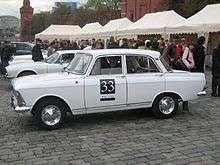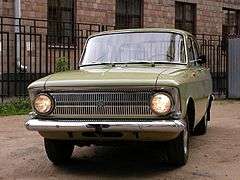Moskvitch 412
| Moskvitch-412/Izh-412 | |
|---|---|
|
| |
| Overview | |
| Manufacturer |
MZMA/AZLK IZh |
| Also called | Moskvitch 1500 SL (export version) |
| Production |
|
| Body and chassis | |
| Class | Compact car |
| Body style |
|
| Layout | FR layout |
| Doors | 4 (5 on the Kombi hatchback model) |
| Related | Moskvitch 408 |
| Powertrain | |
| Engine | 1478 cc UZAM-412 I4 |
| Transmission | 4-speed manual |
| Dimensions | |
| Wheelbase | 2,400 mm (94.5 in) |
| Length | 4,115 mm (162.0 in) |
| Width | 1,550 mm (61.0 in) |
| Curb weight | 1,045 kg (2,304 lb) |
| Chronology | |
| Predecessor | Moskvitch 408 |
| Successor |
|
The Moskvitch 412 (Moskvich 412, Москвич 412, M-412) was a small family car produced by Soviet/Russian manufacturer MZMA/AZLK in Moscow from 1967 to 1975, and by IZh in Izhevsk from 1967 to 1982 (also known as Izh-412). It was a more powerful and prestigious version of the M-408 model, offering more features to the driver for a higher price.[2]
Design
The Moskvitch 412 was a derivate of Moskvitch 408, differing in more powerful 1.5 engine. The earliest engines for the M-412 were built in 1964.[3] The Moskvitch-412 had a slanted (to a tilt of 20 degrees) inline-four engine with a block, head, and inlet manifold cast in aluminium alloy in order not to increase the weight of the engine and a hemispherical combustion chamber.[4] Steel cylinder liners were replaceable to enable easy repair of the engine instead of having to replace it entirely. Since it was of an OHC design it was taller than the OHV MZMA-408 engine it replaced, which is why it was mounted at a slant. The UZAM-412 had a capacity of 1,478 cc (90.2 cu in) c.c. and developed 75 horsepowers. Its more powerful version, the Moskvitch-412-2V, had 100 h.p. and was installed on sports cars.[5] The 1,478 cc (90.2 cu in) UZAM-412 engine, with a light alloy block, was designed by Igor I. Okunev. According to some observers, it bore some similarities to the contemporary BMW M 115 motor used in the BMW 1500 model, although in other ways they are different from each other.[6] The gearbox inherited from the M-408 was improved, with the gearbox ratios being revised to make better use of the increased power output.[7]
In 1969, both the M-412 and the related M-408 had their body redesigned. These were notable for being the first Moskvitch models to feature rectangular headlights and horizontal rear lights, which passed on to the 2138/2140 in 1976, replacing round headlights (two on ordinary models, four mainly on export models) and vertical rear lights. Only rear triangular turn signals remained on vestigial tailfins. Until then, the M-412 profited from heightened tailfins and tanned headlight lamps on export models. Another notable (but not unique, as it was used in other Russian cars at the time) feature were the so-called side signals, mounted on the C-pillars on some vehicles and similar to the American "opera lights". The car was upgraded with dual-circuit brake system, reinforced car-body structure, and passive safety features such as soft grip steering wheel cover, soft interior parts, seat belts, and padded dashboard. It was the first Moskvitch to pass safety features tests in France, Bulgaria, Czechoslovakia, and Sweden in 1970—71, and in Western Germany in 1972.[2] The modernized model, both for export and domestic market, received a factory code M-412IE (IE for "export rendition"), to mark, that it fulfils new safety requirements.[8]
The M-412 was launched in the United Kingdom in 1969, when the first 20 dealerships were set up and some 300 cars were sold; its sales increased annually and peaked in 1973, when some 14,500 cars were exported through a 268-dealer network. However, soon afterwards they was pushed off the British market by the fellow Soviet brand Lada, down to only 3462 sales in 1973 and 344 in 1975,[9] so that Moskvitch decided to withdraw from the United Kingdom.[10] SATRA's 1974 rebranding it the Moskvitch 1500 did not change anything.[9]

SATRA Motors entered M-412s in the Group One Production Saloon Car Championship in 1972 and 1973, where it easily beat "sharp-handling but underpowered" Hillman Imps and Austin Minis.[11] It also placed 1-2-3 in the 1973 Avon Round Britain Rally[11] and scored a class win in the South Africa Safari Rally the same year.[12]
Trims and models
Moskvitch
- M-412, the base sedan model that underwent various adaptations marked by adding different letters such as "E", "I", "U", "P", etc. to its name. They usually meant the class of the vehicle (as in luxury residential, commercial, governmental, sports, export, and so on) and were preferred over precising words used on earlier models. Kerb weight of the 412 was 1,045 kg (2,304 lb).[13]
- М-427, a station wagon on the same base, produced from 1969, replacing the M-426 wagon. In 1972, this got a new one-piece upward-hinged tailgate.[12] AZLK stopped making these in 1976; IZh continued with production until 1982. Starting 1971, the base of this model served to create the Izh-2125 hatchback (see below).
- M-434, which was the unibody sedan delivery and pickup[14] variant that succeeded the M-433 straight from 1967 to 1973 (thereafter it was replaced by the IZh-2715 that increased in popularity by that time). Both this model and the M-427 kept their rear light tailfin design until 1982, and passed it on to M-2137 variants from 1975.
Izh


- IZh-412 — practically similar to M-412, with slight changes in the frontal grille, most notably retaining twin round headlights. The car was still marketed as Moskvich 412 and had such name on a rear hood, while IZh-412 was a factory designation.[15] After a facelift in 1982 it received a black grille with indicators on outer sides of headlights, and hollow door handles (factory code IZh-412-028), and remained in production until 1997.[15]
- IZh-427 was a duplicate of the M-427, with no other changes beside the company logo. The car, however, entered in production only in 1971 because of the abundance in Moskvitch variants.
- IZh-2125 — surnamed "Kombi", was the first Soviet hatchback series produced from 1973 to 1982, then after a facelift as IZh-21251. It was then kept in production until 1997.
- IZh-2715 was IZh's panel van variant with a high roof, produced from 1972 until 2001. In 1982 it underwent a facelift, along with other IZh models (IZh-2715-01 code).[15]
- IZh-27151 was IZh's pick-up truck, produced from 1974 until 2001. After a facelift in 1982 it was designated IZh-27151-01, or IZh-27151-013-01 in lengthened version.[15]
Relationship to the M-408

The original M-412 of 1967-1969 had a chassis identical to that of the Moskvitch-408, which had been launched 3 years earlier in 1964. The only differences between the two models were the engines and the interior.
Here are the main differences between the Moskvitch-412 and the Moskvitch-408:
| Moskvitch 412 | Moskvitch 408 | |
|---|---|---|
| Production | 1967–1976 | 1964–1976 |
| Engine model | 412 | 408 |
| Chassis | 408 (1967–1969); 412 (1969–1976) | 408 (1964–1969); 412 (1969–1970) |
| Successor | Moskvitch 2140 | Moskvitch 2138 |
The differences between the 412/408 chassis:
| 1969 - 1975 | 1967 - 1969 | |
|---|---|---|
| Features | Square headlights; horizontal rear lights; triangular rear turn signal markers; separated front seats; floor mounted gearshift lever (except for the 408 which had column-mounted shifter until 1973). | 2 or 4 (twin) round headlights (Izh-412: 1967 - 1982); vertical rear lights; front bench seat (until 1968); column mounted gearshift lever (on the 408 until 1973, on the 412 until the fall of 1968). |
Prototype variants
In 1970, Moskvitch built a prototype of the M-353, a restyled hatchback version of the M-412 that was larger but recognizably related. The M-355 of 1972 was larger still, with 23 cm (9.1 in) greater length, 14 cm (5.5 in) more wheelbase, and 8 cm (3.1 in) more width.[16] This made both the interior and the boot noticeably larger.[16] The M-355 was further developed into the M-356 between 1973–1975, with "much bolder front end styling", new suspension, and an enlarged 1,799 cc (109.8 cu in) version of the Moskvitch-DM with twin Zenith carburetors, giving 103 hp (77 kW; 104 PS), with a Borg-Warner transmission planned.[16] None were built.
Grilles

 Restyled M-412 grille used from 1969 to 1975, also featured on the M-408 during the same years.
Restyled M-412 grille used from 1969 to 1975, also featured on the M-408 during the same years. Upmarket "tanned" grille, used mainly on export models.
Upmarket "tanned" grille, used mainly on export models. M-426 estate model used the new grille since 1969.
M-426 estate model used the new grille since 1969..jpg) Similar grille featured on the 1973—1982 "Kombi", a hatchback car based on the M-412. Turn lights were moved up.
Similar grille featured on the 1973—1982 "Kombi", a hatchback car based on the M-412. Turn lights were moved up.
Modifications
.jpg) Moskvitch-412
Moskvitch-412- Rally car
- Moskvitch-427 estate
- Izh-2715 van (early model)
- IZh-27151-013-01 Pickup truck
References
- ↑ Moskvich - The Son of Moscow, www.ucapusa.com Retrieved 26 January 2014
- 1 2 (Russian) "The Moskvitch-412".
- ↑ Za Rulem magazine: the Moskvitch-412 (Russian)
- ↑ Braunschweig, Robert; et al., eds. (12 March 1970). "Automobil Revue '70" (in German and French). 65. Berne, Switzerland: Hallwag AG: 413.
- ↑ (Russian) "The Moskvitch-4G, -4A, -4M".
- ↑ Thompson, Andy (2008), Cars of the Soviet Union: The Definite History, Sparkford, Yeovil, Somerset: Haynes, p. 149, ISBN 978 1 84425 483 5
- ↑ Za Rulem magazine: the Moskvitch-412 (Russian)
- ↑ (Russian) Moskvitch-412, "Avtolegendy SSSR" Nr. 46, DeAgostini 2010, ISSN 2071-095X, p.5-6
- 1 2 Thompson, p.162.
- ↑
- 1 2 Thompson, p.160.
- 1 2 Thompson, p.163.
- ↑ Thompson, p. 152.
- ↑ Thompson, p. 159.
- 1 2 3 4 IZh-412-028, "Avtolegendy SSSR" Nr. 85, DeAgostini 2012, ISSN 2071-095X (in Russian)
- 1 2 3 Thompson, p. 164.
| Wikimedia Commons has media related to Moskvich 412. |